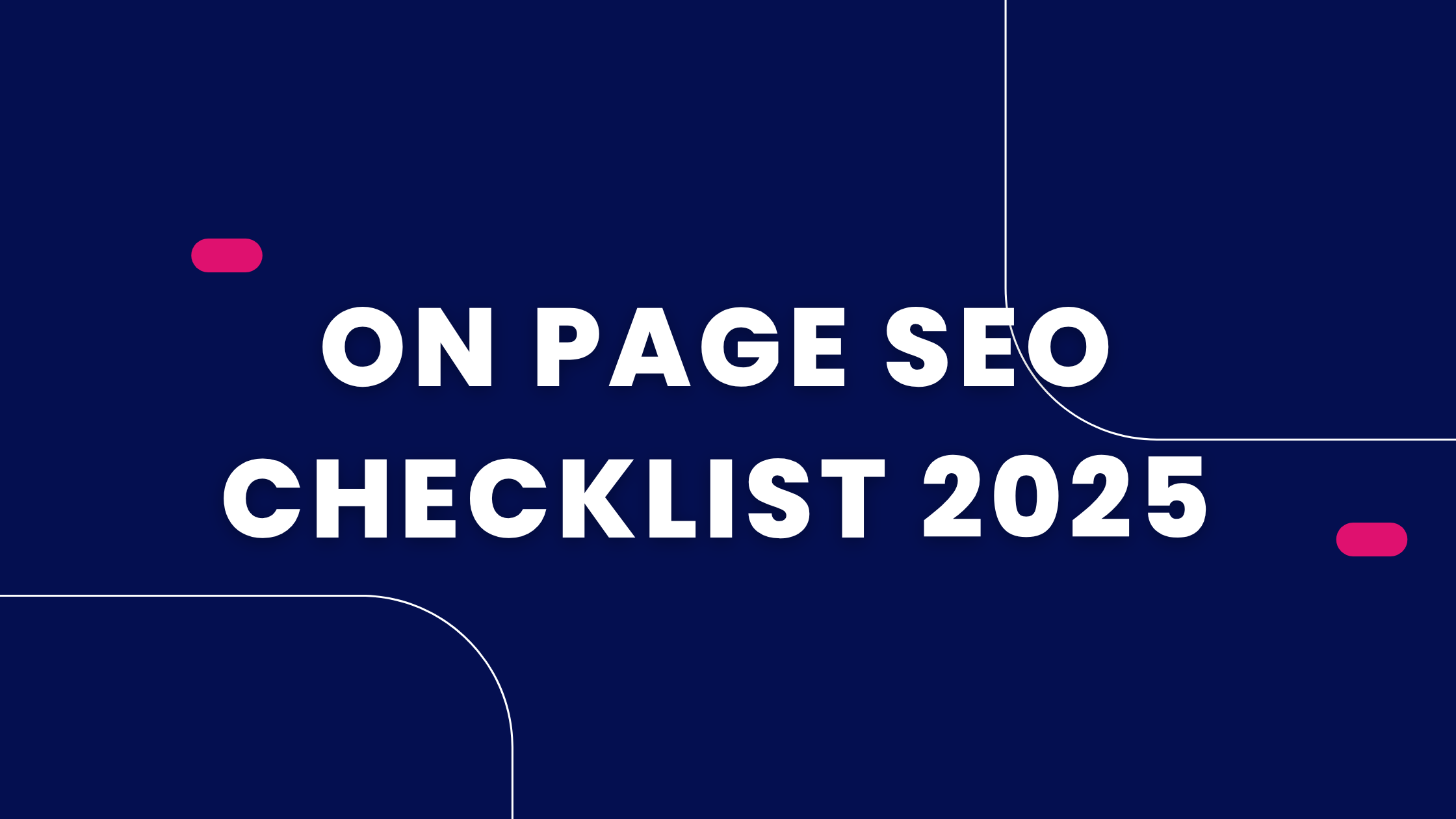Ecommerce On-Page SEO Checklist: Everything You Need to Rank Higher

1. Introduction
Ever wondered why your competitor’s online store ranks higher on Google while yours stays buried on page 3? The answer might be right under your nose: on-page SEO.
On-page SEO for ecommerce is about making sure every page on your site is speaking Google’s language—and doing it better than the competition. From your homepage to your last product listing, every word, image, and link needs to work in harmony to boost visibility.
Let’s break it down with a no-fluff, action-ready checklist that will take your ecommerce SEO to the next level.
2. Ecommerce On-Page SEO: The Foundation
2.1. Understanding Search Intent for Ecommerce
Before you optimize, you’ve got to understand what your customers are actually searching for. Are they ready to buy? Just browsing? Looking for reviews?
Map your content to the user’s buying stage—informational, navigational, or transactional—to maximize conversion and rankings.
2.2. Keyword Research for Product and Category Pages
Use tools like Google Keyword Planner, Ahrefs, or SEMrush to find profitable keywords. Don’t just chase volume—intent is everything.
- Long-tail vs. Short-tail: Go long-tail for more precise intent and lower competition.
- Group keywords by intent: Separate those ready to buy from those still researching.
3. Site Architecture That Supports SEO
3.1. Importance of a Crawlable and Scalable Site Structure
Your site should be easy for both users and search engines to navigate. Keep pages no more than 3 clicks deep from the homepage.
3.2. Flat vs Deep Architecture in Ecommerce
Flat structures perform better in SEO. Users and crawlers reach all content quickly—this improves both UX and indexing.
3.3. Best Practices for URL Structure
- Keep URLs short and descriptive
- Avoid dynamic parameters (e.g., ?id=1234)
- Include relevant keywords naturally
4. Optimizing Category Pages
4.1. Why Category Pages Are SEO Goldmines
Category pages target broad keywords with high search volume. They act as gateway pages for users and search engines alike.
4.2. Writing SEO-Friendly Category Descriptions
Use 150–300 words to describe the category with relevant keywords. Make it engaging—like you’re guiding a friend to the perfect product.
4.3. Internal Linking from Categories to Products
Link to your best-selling and high-converting products. This distributes link equity and helps users discover products faster.
4.4. Schema Markup for Categories
Add breadcrumb schema to help search engines understand the hierarchy of your site.
5. Optimizing Product Pages
5.1. Crafting Unique Product Descriptions
Don’t just copy the manufacturer’s text. Write something that connects with your customer, solves their pain points, and uses keywords naturally.
5.2. Avoiding Duplicate Content Across Similar Products
Use canonical tags for variants, or dynamically load data instead of creating separate pages for color or size changes.
5.3. Using Keywords Naturally in Titles, Headers, and Body
Always include the primary keyword in the H1, meta title, and first 100 words of the product description.
5.4. Optimizing Product Images
- Use descriptive file names (e.g., red-leather-wallet.jpg)
- Add alt tags with keywords
- Compress images for faster load times
5.5. Using Structured Data for Rich Snippets
Add schema markup for reviews, price, availability, and product to improve CTR from SERPs.
6. Technical SEO Essentials for On-Page Success
6.1. Mobile Optimization and Responsive Design
Use mobile-first design and test with Google’s Mobile-Friendly Test tool.
6.2. Site Speed and Core Web Vitals
Use tools like PageSpeed Insights to improve LCP, FID, and CLS. Fast-loading pages lead to better rankings and lower bounce rates.
6.3. HTTPS and Secure Checkout
SSL is a ranking factor and a trust signal. Make sure your entire site is served over HTTPS.
6.4. Canonical Tags to Prevent Duplicate Content
Use canonical URLs to tell Google which version of a page to index when you have variations or filters.
6.5. Creating and Optimizing an XML Sitemap
Submit your sitemap to Google Search Console. Ensure all key pages are included, and exclude paginated/filter pages.
6.6. Robots.txt Configuration for Ecommerce Sites
Block search result pages and faceted URLs that add no value. Keep it clean and crawl-friendly.
7. Internal Linking Strategy
7.1. The Role of Internal Links in Ecommerce SEO
They pass authority, help Google discover pages, and improve UX. Link contextually within content.
7.2. Using Breadcrumb Navigation
Helps users and search engines understand site structure. Add schema for breadcrumbs.
7.3. Linking from Blog Content to Products
Blog posts are great for SEO and conversions. Link to relevant products naturally within the content.
8. Content Marketing Integration
8.1. Blogging for SEO and Brand Authority
Write about industry trends, how-tos, and product use cases. Optimize blog posts with keywords but avoid keyword stuffing.
8.2. Creating Buying Guides and Tutorials
These longer-form contents attract backlinks and help customers make purchase decisions.
8.3. Video Content and SEO Benefits
Embed videos on product and category pages to boost engagement and dwell time.
10. User-Generated Content for SEO
10.1. Leveraging Reviews and Testimonials
Reviews add fresh content and keywords, boost trust signals, and can be marked up with schema.
10.2. Handling Spam and Moderation
Keep your UGC clean and relevant to maintain quality and prevent penalties.
11. Image and Video Optimization
11.1. Alt Text Best Practices
Write descriptive alt text for accessibility and SEO. Include primary keywords naturally.
11.2. Video Sitemaps
If you use videos, submit video sitemaps to help Google index your multimedia content.
12. Optimizing for Local SEO
12.1. Google My Business and Local Listings
Register and optimize your Google My Business profile with accurate NAP data.
12.2. Localized Content and Keywords
Include location-specific keywords on relevant pages.
13. Leveraging Schema Markup
13.1. Product, Review, and Offer Schema
Use JSON-LD structured data to mark up products, prices, availability, and reviews.
14. Handling Out-of-Stock or Discontinued Products
14.1. SEO Best Practices for Out-of-Stock Pages
Provide alternative recommendations or use “Notify me” options to keep users engaged.
15. Multi-Language and Multi-Currency SEO
15.1. hreflang Tags and URL Structure
Properly configure hreflang to avoid duplicate content and serve correct language/currency to users.
16. Optimizing Site Search and Filters
16.1. Search Function SEO Impact
Improve internal search UX and use analytics to identify new keywords and customer pain points.
17. Conversion Rate Optimization Meets SEO
17.1. Aligning SEO and CRO Strategies
SEO drives traffic; CRO turns traffic into customers. Align your messaging and page experience for both.
18. Tracking, Measuring, and Improving SEO
18.1. Google Analytics and Search Console Setup
Track performance, identify issues, and spot opportunities to improve rankings and conversions.
19. Common Ecommerce SEO Mistakes to Avoid
19.1. Keyword Stuffing and Thin Content
Avoid over-optimization and provide valuable, unique content on all pages.
19.2. Ignoring Mobile and Site Speed
Mobile traffic dominates. A slow or poorly designed site loses customers and rankings.
20. Future-Proofing Your Ecommerce SEO Strategy
20.1. Staying Updated with Algorithm Changes
SEO evolves. Keep learning and adapting your strategies to stay competitive.
21. Frequently Asked Questions
Q1: How often should I update product pages for SEO?
Ideally, update product descriptions and images seasonally or when you add new features or reviews.
Q2: Should I index filter and faceted pages?
Generally, no. These often create duplicate content. Use noindex or canonical tags wisely.
22. Conclusion
Ecommerce on-page SEO is a marathon, not a sprint. By following this checklist, you lay down a solid foundation for organic growth and better user experience. Remember: it’s about helping your customers find exactly what they need — fast and easy.
Keep testing, learning, and optimizing. Your next sale could be one tweak away.

